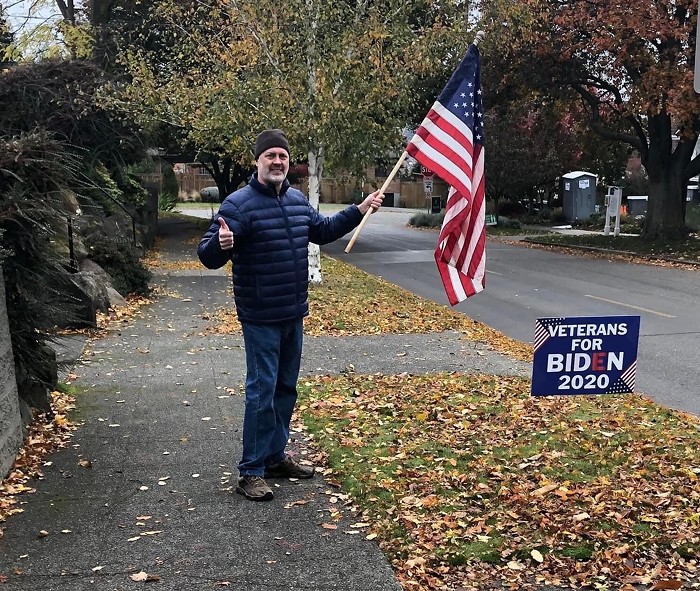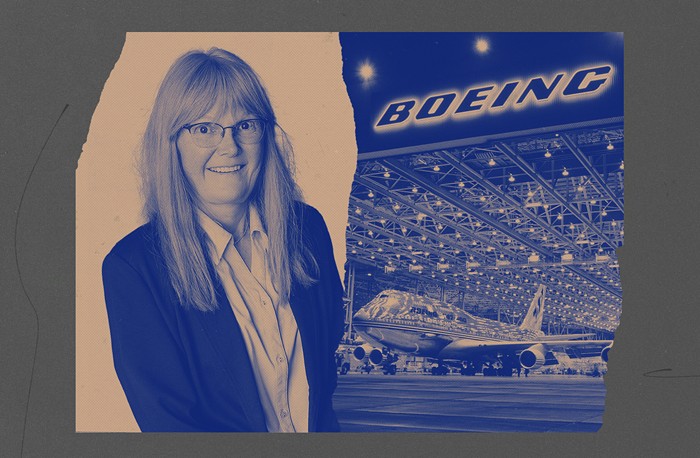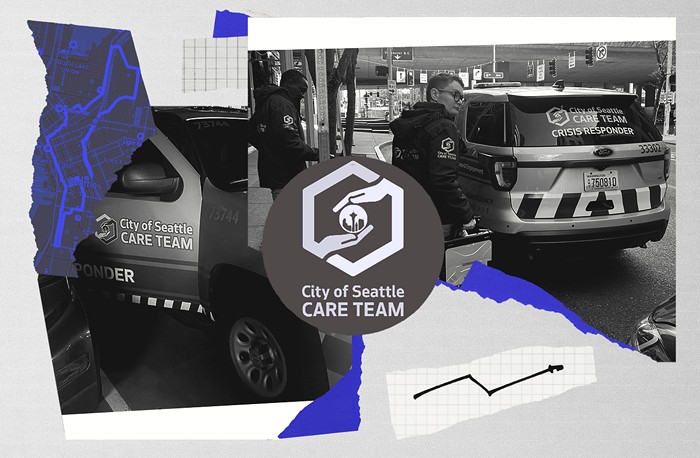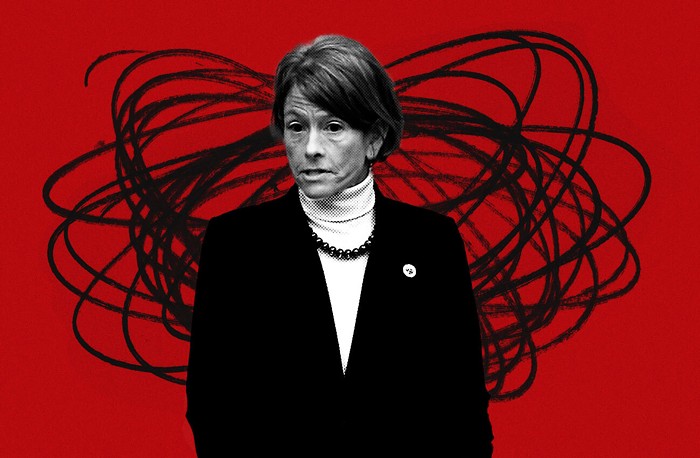[Tim Eyman's Initiative 776 got overturned], but you're still fending off a lawsuit that says Sound Transit's 14-mile, $2.4 billion plan--scheduled to open between 2009 and 2011 and serve 42,000 daily riders--is not what voters approved. The plaintiffs have a point. Voters approved a 21-mile, $2.1 billion plan scheduled to open in 2006 and serve 127,600 daily riders. How do you sit at a bar with a voter and say, "We're asking for more money for a shorter line that will open five years later and serve one-third of the original ridership, but we're still doing what you asked for"?
I reject the premise of the question. The question is not: "You're paying more to go less far and carry fewer people." Read the Sound Move plan. It contemplates that we will build a 21-mile system in two segments--the first one from downtown going south, then north to the University District. The [current] 14-mile segment is the southern segment, and will capture the same ridership that was envisioned in that segment of the plan. The other two-thirds of it is in the north. We're still committed to doing it. The southern segment is not a stand-in for the 21 miles. It's building the first part of the plan.
We're doing an [environmental impact study] to find a cheaper way to get north. This is going to play out beyond 2006, and that's a legitimate question, to the extent that the plan was billed as a 10-year plan. But the question to the voters in '96 was: "Do you want to levy these taxes for the purposes of building a regional transit system?" The question was obviously answered in the affirmative, overwhelmingly. [Voters] constituted the board, giving it the authority to build the system. So that's where we find ourselves. It's going to cost more than originally thought. It's going to take longer than originally thought. But the ability to deliver the project as originally defined is still within our grasp and on our table.
So your position is: Phase One was approved and Sound Transit's taxing authority exists to get us from the U-District to the airport, even though it will cost more than the dollar amount approved in 1996. What check do voters have? Would you be willing to put a cap on the taxes? I'm a little nervous because in King County Superior Court you argued that you could levy the tax in perpetuity.
The judge did a thorough reading of the law. We're obligated to stop building at the end of Phase One. If we're going to build new projects, we have to ask the voters whether they want to keep going and approve additional taxes. The real question is, are we ever in this region going to decide that it's time to do something about the transportation problem? This is the best opportunity we've had in 30 years to add meaningful capacity to the regional transportation system, and the board isn't going to backtrack on that opportunity.
Can you give us a sense of what the northern route will cost?
We have sifted through multiple routes, looking for the ones that have cost savings. But until the technical and ridership [data] is put together, I'm not going to speculate. By May, we'll have three alternatives, one of which is the original plan. That will trigger a process including public outreach; we'll identify a preferred alternative sometime in the summer, and work toward a formal route adoption and finance plan.
The original plan went across Portage Bay. The new ones are right under I-5 to the west, and under the Montlake Cut to the east. So back to your guy sitting on the barstool. He has every right to be pissed that it's going to cost more and take longer. [But] that's the situation we find ourselves in. Show me a major capital project that doesn't have similar problems. The fact is, we're building what was described in the plan.
Where's the money to get to the airport? You have about $21 million left, according to Sound Transit's 2002 financial plan.
We're not going to put out any cost estimates on any part of our project until we know those are numbers we can stand behind.
Could it be less than $21 million?
I think it'll be more than that. As the design process goes forward, we'll be able to develop a reliable cost estimate. At that point, the board will decide how they're going to do it. We have a number of tools. We've got financial revenues from that sub-area, and there are other pots of federal funding. The Port has other pots of local and federal funding. We're looking to cost-share on the alignment.
This highlights Eastside King County Council Member Rob McKenna's question about sub-area equity. He's afraid that Sound Transit will violate its governing principle of sub-area equity by borrowing revenues from his district [East King County] to pay for things like the airport extension in South King County. He's got a point. When you look at Sound Transit's 2002 financial plan and the federal grant application, Eastside bonding capacity is held up as proof of Sound Transit's ability to cover the federal loan. The feds think, "Okay, Sound Transit has the money." Based on that, Sound Transit could be contractually obligated to the feds for money it doesn't have.
If you look at the East King sub-area, it's piling up money. It's the richest sub-area, and nobody foresaw that in 1996. But their project list won't come close to spending the amount of money they have. Sub-area borrowing occurs. If people are worried about getting their money back, it's a legitimate worry when they're doing some loaning. But there's no movement afoot or support on the board to violate the principal of sub-area equity. If they were going to change the policy, it would require a supermajority.
Sub-area borrowing enables us to manage our cash flow in the most efficient way possible to fund our projects in the order we're sequencing them. We have to square the books at the end of every year. So if there's a project under development in South King and there's a loan to that project from North King, they have to pay that back at the end of every year. If they need it again next year, they borrow it again. But there's a check every year. At the end of the project, all the books have to square--that's a statutory requirement, as opposed to just a policy of the board.
The Seattle Popular Monorail Authority's 14-mile, above-grade monorail plan is penciling in cheaper per mile than Sound Transit's at-grade, 14-mile line. Shouldn't we just go with one system that offers a more efficient rapid technology?
Monorail is an intermediate-capacity transit system that works very effectively in a dense urban environment. Light rail is a high-capacity system more appropriate for moving large numbers of people within a regional context. [Our] trains can carry 600 people at two-minute headways. They're designing their system, their platforms, and their stations for trains that are going to carry 150-200 people.
And light rail is not just an at-grade system. We have at-grade construction, tunnel construction, and elevated construction. We're going to be running 55 mph in our grade-separated alignments. At [Martin Luther King Way], we're running at the posted speed limits, but our trains [will] have the ability to jump signals. So the aggregate average speed is about 28 mph, which is probably a mile or two an hour faster than [monorail]. When you say, "It's cheaper, it's faster, it's more efficient," I don't think the facts bear that out.
There's a bill in Olympia to have an elected Sound Transit board. What do you think?
We're required to go to every jurisdiction we cross and get permits. The theory behind our board [structure] is that we have people who represent the jurisdictions we're in, and they're in a position to facilitate the permit process. If we didn't have that, we'd be in a very adversarial posture with every jurisdiction we came through.
Five hundred million dollars in federal money is assumed in the current 14-mile plan. Where is that money?
The president's budget, released this week, proposes $75 million--our third draw on the total $500 million. That clearly tips the administration's hand on what they think about this project. The final decision on the full grant will be made in early summer.


















